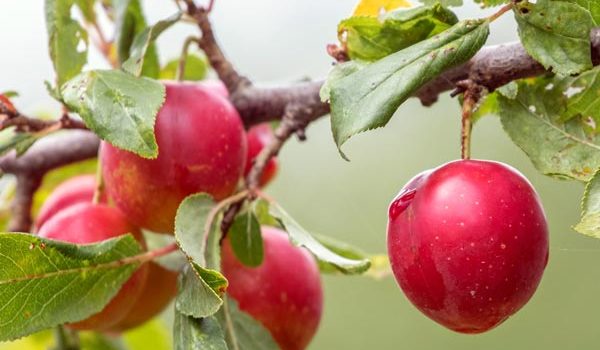- Shop
- Apparel
- Berries
- Books
- Bundles
- Citrus
- Fertilizer & Pest Control
- Fruiting Ground Covers
- Fruiting Shrubs
- Fruiting Trees
- Herbs, Spices, and Teas
- Mason Bees
- Nitrogen Fixers and Companion Plants
- Northwest Natives
- Nut Trees
- Ornamentals & More
- Perennial Vegetables
- Rootstock
- Subtropical Fruits
- Tools
- Vines
- Xeriscape
- Sale Items
- Information
- Nursery News
- Contact Us
- My Account

Understanding Plant Nutrition
Fertilizers often have three numbers on them, and gardeners at many stages may find themselves scratching their head at this. There are three major elements that all plants need: Nitrogen, Phosphorous, and Potassium. The values on fertilizers are referred to as NPK, to reflect those elements. The ratios on fertilizer labels represent the percentage of those nutrients in the mixture. Let’s dive into understanding these three important nutritional ingredients!
It’s no secret that plants are living beings, and just like us animals, plants also need a well-balanced diet in order to thrive. Consider fertilizers to be like multivitamins for your plants. While plants are already naturally great at absorbing nutrients in the soil and in the air the reality is that they often cannot access all of the important nutrients necessary for excellent health. There may be some chemicals already available in the soil and air but the reality is that more often than not these sources do not readily provide all the ingredients required for optimal growth. In fact, the nutrients that plants need most are often lacking first because plants already use large amounts of them to survive and grow. Therefore, it is important for gardeners to understand the nutritional ingredients that plants require and that fertilizers offer.
NPK – Primary Macronutrients
Nitrogen (N) is crucial to plant growth and development. This is what gives plants their rich green pigmentation due its involvement in chlorophyll production, the main chemical involved in photosynthesis (which is how plants convert sunlight into food). Yellowing leaves is a common sign of nitrogen deficiency. If it is overused it may accelerate the plant growth faster than their roots are able to support, which is why it is important to know that nitrogen stimulates above-ground growth.
Phosphorus (P) is necessary in the development of seedlings and young plants. Phosphorus promotes vigorous root development and growth. This nutrient can help speed up plant maturity and by anchoring and strengthening plants. It also plays an important role in cold hardiness, disease resistance, and efficient use of other important nutrients. Common signs of phosphorus deficiency in plants are stunted growth and often a dark-green color, sometimes a reddish-purple, and occasional yellowing in very young plants. Phosphorus improves rooting, blooming, fruiting, and seed formation.
Potassium (K) is integral to the overall vigor and growth of plants. This macronutrient helps plants digest and manufacture their foods and absorb water. The word potash refers to potassium-bearing salts and minerals. Potassium strengthens plants’ ability to fight off diseases as well as withstand cold temperatures and dry conditions. Plants with a potassium deficiency often display stunted growth and drought sensitivity, so it can be especially important in arid and cold climates. Potassium promotes healthy reproduction, growth, and overall vigor.
Secondary Macronutrients
In an effort to understand the “big three” NPK primary macronutrients, many other crucial nutrients are unfortunately often overlooked. They are called secondary macronutrients. Let’s explore some of these!
Calcium (Ca) improves absorption of other nutrients by roots, and can help improve disease resistance. This nutrient is important to the cell walls and the right amount helps ensure plants stay upright. Generally, calcium helps with growth of young shoots and roots. It also contributes to maintaining a favorable soil pH.
Magnesium (Mg) is essential for plants to metabolize phosphorus. Without magnesium, plants could not absorb phosphorus. Additionally, it is essential for enzyme activation and plant respiration. Water-soluble fertilizer helps make magnesium more readily available to plants already growing in deficient soils.
Sulfur (S) maintains a deep green color due to its essential role in protein synthesis, chlorophyll development, and photosynthesis. Sulfur deficiency in plants may seem to resemble nitrogen deficiencies in its yellow discoloration. The difference is that a plant’s need for nitrogen initially displays this on old growth, whereas a lack of sulfur is displayed by discoloration on new growth.
Furthermore, there are trace minerals that are needed in much smaller amounts for healthy plants. These trace minerals are called micronutrients. These are boron, chlorine, copper, iron, manganese, molybdenum, nickel, and zinc.
Application
Before applying NPK fertilizer, it is important to understand that there can be drawbacks of overusing them. Unlike soil amendments, the nutrition in fertilizers become available to plants as soon as they are dissolved by water. Too much fertilizer causes excessive vegetative growth and inhibits fruiting. Remember, fertilization is not done to keep plants alive, but to make sure they grow their best! Please read the instructions on our product pages and on the box for application guidance.
Each type of soil has its own unique blend of nutrients, so before deciding what to feed your plants, it is worth having a good idea of the chemistry, structure, and type of soil they are or will be growing in. Our plants will return the favor of such an understanding with more robust flowers, leaves, and fruits.
